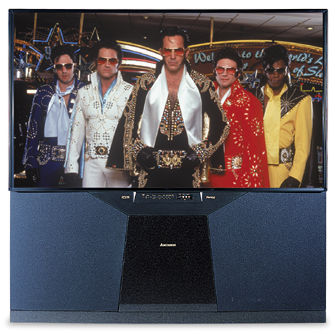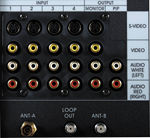Mitsubishi WS-73711 73-Inch HDTV
Everybody loves new toys. When you're a geek like me, new toys come in the form of test equipment. This year, Christmas came early for the Home Theater video department, as we finally got the OK to buy an HDTV test-pattern generator. Woo-hoo! OK, so maybe test-pattern generators aren't your idea of fun. Maybe a 73-inch rear-projection TV is your idea of fun. Well, we got one of those in, too.

Mitsubishi sent us the WS-73711, their new top-of-the-line model, which uses 9-inch CRTs. Most rear-projection TVs use 7-inch CRTs. The additional size is supposed to improve light output and increase resolution. It was the increased resolution that I was most interested in. The coolest test pattern on our new generator is the one that indicates how many horizontal pixels in a high-definition signal (or a standard-definition signal, for that matter) reach the screen. I figured that the Mitsubishi's 9-inch guns would be a good benchmark by which to judge later review samples.
Regardless of the results of the resolution test (which I'll get to in a second), the WS-73711 is a solid home theater product. The back panel has more connections than many receivers, including four A/V inputs on the back and one on the front. Each of these inputs offers composite and S-video connections. Add two Y/Pb/Pr inputs that can accept either interlaced or progressive DVD signals, a computer input, and a five-wire HD input, and you have more connections than you should need. The latter can accept either RGBHV or Y/Pb/Pr signals, which makes the set very flexible. The PC input is a welcome addition, even if it only runs at a 640:480 resolution. There's even an audio output for the picture-in-picture signal.
 The built-in HD tuner is also a big bonus. The set accepts and decodes both off-air and cable signals, and it provides three IEEE 1394 ports for connection to other devices. I tested the 1394 link in the February 2002 issue using Mitsubishi's WS-55859 HDTV and one of their D-VHS players, and it worked great. I can't wait for 1394 to be an industry standard. I had no trouble tuning in all of the local HD stations, although I was surprised to see some macro blocking. This was particularly noticeable with fast-moving, brightly colored objects. I can't say that it was any better or worse than our reference Panasonic tuner, however. At least the WS-73711's tuner picks up PSIP data. PSIP tells you what channel you're watching (i.e., our local CBS affiliate shows up as channel 2.01, a subset of the analog channel 2, even though the digital channel is broadcast on channel 60) and anything else the station may have programmed into the data stream, which at this point is almost nothing.
The built-in HD tuner is also a big bonus. The set accepts and decodes both off-air and cable signals, and it provides three IEEE 1394 ports for connection to other devices. I tested the 1394 link in the February 2002 issue using Mitsubishi's WS-55859 HDTV and one of their D-VHS players, and it worked great. I can't wait for 1394 to be an industry standard. I had no trouble tuning in all of the local HD stations, although I was surprised to see some macro blocking. This was particularly noticeable with fast-moving, brightly colored objects. I can't say that it was any better or worse than our reference Panasonic tuner, however. At least the WS-73711's tuner picks up PSIP data. PSIP tells you what channel you're watching (i.e., our local CBS affiliate shows up as channel 2.01, a subset of the analog channel 2, even though the digital channel is broadcast on channel 60) and anything else the station may have programmed into the data stream, which at this point is almost nothing.
The set has numerous other cool features, including NetCommand, the system-integration feature that Mitsubishi introduced last year (and we reviewed more thoroughly in the February 2002 issue). The set already has IR emitters on the back panel, which allow you to control hidden components like DVD players or A/V receivers by looping those components' remote signals through the TV screen. However, this still requires that you use several remotes or program the various component functions into one remote. The WS-73711's controller, for example, can control five different components with the flip of a switch.
 NetCommand takes this one step further. The TV remote can control your whole system. The display uses an icon-based menu to provide the basic functions you need for all of your gear. When you select the DVD input, for instance, the DVD functions appear on the screen, while the TV and A/V receiver automatically change to the appropriate inputs. Highlight play and press enter, and the TV generates the appropriate command and sends it to the DVD player. Once NetCommand is set up, it works rather well and allows the typical theaterphile to leave the house with confidence that his or her family can still watch TV in their absence.
NetCommand takes this one step further. The TV remote can control your whole system. The display uses an icon-based menu to provide the basic functions you need for all of your gear. When you select the DVD input, for instance, the DVD functions appear on the screen, while the TV and A/V receiver automatically change to the appropriate inputs. Highlight play and press enter, and the TV generates the appropriate command and sends it to the DVD player. Once NetCommand is set up, it works rather well and allows the typical theaterphile to leave the house with confidence that his or her family can still watch TV in their absence.
NetCommand's only drawback is the effort needed to set it up (I had the same gripe last year). Hopefully, your dealer can help you out. Even if you understand that the remote codes that a manufacturer uses for one model are the same ones they use for nearly every model, you may not find all of your system's products listed in the NetCommand library.
Fortunately, the rest of the WS-73711's setup process is really easy, thanks to the attractive and intuitive onscreen menu and the ergonomically designed remote. The system is also pretty flexible. There are enough aspect-ratio settings to satisfy anyone, although it'd be nice if the display automatically recognized the anamorphic flag encoded in a DVD. You can adjust each input separately so that each source looks its best. The WS-73711's black level stays pretty consistent with varied material, so there's no need to compromise with the brightness control. As the color decoder is fairly accurate, you can also set the color level at or near the ideal setting. There's a slight red push, which makes faces look a little pink, but it's not objectionable.
In fact, after just a few tweaks of the main picture controls, the TV's overall performance was fairly good. Images pop from the screen and are more than sufficiently bright, even with the contrast accurately set at about 25 percent. The WS-73711's comb filter eliminates most artifacts from static composite sources, but moving images still show some dot crawl. The composite input also exhibited a couple of other artifacts that weren't present with S-video or component signals. As always, I recommend using the component connection whenever possible. The ability to disable scan velocity modulation is a huge help and makes both NTSC and HDTV images look extremely sharp without the resulting ghosts or double edges.
The WS-73711's image improves significantly when you have the set professionally calibrated. The image color, or gray scale, is mildly bluish beforehand but becomes more consistently natural and rich after calibration. A really good technician can also improve the color decoder, which makes the image extremely vibrant and eliminates the red push. The resulting color fidelity and detail are outstanding. Combine this with the huge image, and you'll feel like you're at the movies.





























































